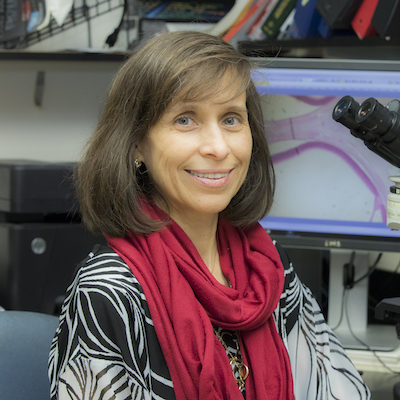
Katia Del Rio-Tsonis
Biographical Information
Katia Del Rio-Tsonis has concentrated her recent research efforts in the understanding of the cellular and molecular events that take place during tissue regeneration, more specifically in the process of retina and lens regeneration. Several animal models are used in her lab including the embryonic chick and amphibians such as newts, axolotls and frogs.
Some adult salamanders have the remarkable ability of regenerating the entire lens and retina after removal. This is achieved by the dedifferentiation of the iris pigment epithelial cells (IPECs) and of the retinal pigmented epithelial cells (RPECs), respectively. These cells lose their pigments and reprogram to either lens cells or retina cells. This transition from one adult cell type to another is unique and involves specific regulation at the gene level. In vivo, this ability for pigmented epithelial cell (PEC) reprogramming and regeneration is restricted to some adult salamanders and several embryonic animals. However, PECs from many other adult animals, including humans, do retain the capacity for reprogramming when isolated and cultured in vitro.
The embryonic chick is one of the preferred models to study retina regeneration, as it is able to regenerate its retina within a very short period, not only by reprogramming of RPECs, but also via the activation of stem/progenitor cells present in the anterior region of the eye.
Using both animal models, the focus is to determine the mechanism of reprogramming and regeneration by dissecting important molecules (transcription factors, injury signals, secreted factors, miRNAs), signaling pathways and epigenetic regulators.
Her lab collaborates with Dr. Mike Robinson’s lab and Justin Saul’s lab, to apply the knowledge obtained on how these animals regenerate their retina, to a novel in vitro human model. This model consists on using engineered human induced pluripotent stem cells (non-embryonic like stem cells) to make RPECs. These cells are responsible for retina regeneration in salamanders. The short-term goal of this research is to be able to generate different human retina cell types from these pigmented cells upon treatment with key molecules. The ultimate goal is to be able to replace lost retina cells in patients that suffer from blinding conditions.
The overall goal is to understand the molecular and cellular mechanisms involved in the process of regeneration from the terminally differentiated PECs or retinal stem cells to the newly formed lens and retina. This will provide important information for the understanding of the development of such tissues, and could provide possible tools for future therapies for the already existing diseases of the eye that affect the lens (cataracts) and the retina (retina degenerative diseases such as Cone-Rod Dystrophy, Best Disease, Stargardt Disease, Diabetic retinopathy, and Age related
Education
- Ph.D., National University of Mexico, Developmental Biology; Tissue Regeneration
Selected Publications
- Vergara, M.A., Tsissios G and Del Rio-Tsonis, K. Lens regeneration: A historical perspective. Int. J. Dev. Biol. 62(6-7-8):351-36, 2018.
- Echeverri NP, Haynes T, Landers J, Gemma, M, Woods J, Gemma M, Hughes M and Del Rio-Tsonis, K. The antioxidant NAC induces chick retina regeneration. Dev Biol. 433(2):394-403, 2018.
- Esquivel Grajales E, Luz-Madrigal Z, Briely J, Haynes T, McKinney Z, Reis E, Han Z, Gutierrez C, Lambris J, Tsekou A, Tsonis PA, and Del Rio-Tsonis, K. Complement component C3a orchestrates early eye morphogenesis. In Dev. Biol. 428(1):88-100, 2017.
- Zhu, J, Luz-Madrigal, A, Haynes T, Burke, AK, Zavada, J and Del Rio-Tsonis, K. B-catenin inactivation is a pre-requisite for chick retina regeneration. PLoS One 9(7):e101748, 2014.
- Luz-Madrigal A, Grajales-Esquivel E, McCorkle A,DiLorenzo AM, Barbosa-Sabanero K, Tsonis PA, Del Rio-Tsonis K. Reprogramming of the chick retinal pigmented epithelium after retinal injury. BMC Biol. 12(1):28, 2014.
- Haynes T, Luz-Madrigal A, Reis ES, Echeverri Ruiz NP, Grajales-Esquivel E, Tzekou A, Tsonis PA, Lambris JD, Del Rio-Tsonis K. Complement anaphylatoxin C3a is a Potent Inducer of Embryonic Chick Retina Regeneration. Nat Commun. 4: 2312, 2013.
- Suetsugu-Maki R, Maki N, Nakamura K, Sumanas S, Zhu J, Del Rio-Tsonis K and Tsonis PA. Lens regeneration in axolotl: new evidence of developmental plasticity. BMC Biology 10(1):103, 2012.
- Tsonis PA, Haynes T, Maki N, Casco-Robles MM, Yamada S, Miura T, Chiba C and Del Rio-Tsonis K. Controlling gene loss of function in newts with emphasis on lens regeneration. Nature Protocols 6(5): 593-9, 2011.
- Vergara MN and Del Rio-Tsonis K. Retinal regeneration in the Xenopus laevis tadpole: a new model system. Mol. Vis. 15:1000-10013, 2009.
- Haynes, T, Gutierrez, C, Aycinena, JC, Tsonis, PA and Del Rio-Tsonis, K. BMP signaling mediates stem/progenitor cell induced neural retina regeneration. PNAS 104(51):20380-5, 2007.
- Spence JR, Madhavan M, Aycinena JC, and Del Rio-Tsonis K. Retina regeneration in the embryonic chick is not induced by spontaneous Mitf downregulation, but requires FGF/FGFR/MEK/ERK dependent upregulation of Pax6. Mol. Vision 13:57-65, 2007.
- Madhavan M, Haynes, T, Call MK, Frisch, N, Call, MK, Minich CM, Tsonis PA, and Del Rio-Tsonis K. The role of Pax-6 in lens regeneration. PNAS 103(40):14848-53, 2006.
- Grogg, M.W, Call, K.C, Okamoto, M., Vergara, M.N., Del Rio-Tsonis, K. and Tsonis, P.A. BMP inhibition-driven regulation of six-3 underlies induction of newt lens regeneration. Nature 438(7069):858-862, 2005.
- Spence, J.R.,Madhavan, M., *Ewing, J.D., Jones, D. K., Lehman, B. M., Del Rio-Tsonis, K. The hedgehog pathway is a modulator of retina regeneration. Development 131(18): 4607-4621, 2004.
Courses Taught
- BIO 361W: Patterns in Development (Writing Intensive)
- BIO 449-549W: Biology of Cancer (Writing Intensive)
- BIO 491: Senior Seminar
- BIO 710: Graduate Seminar in Development and Regeneration